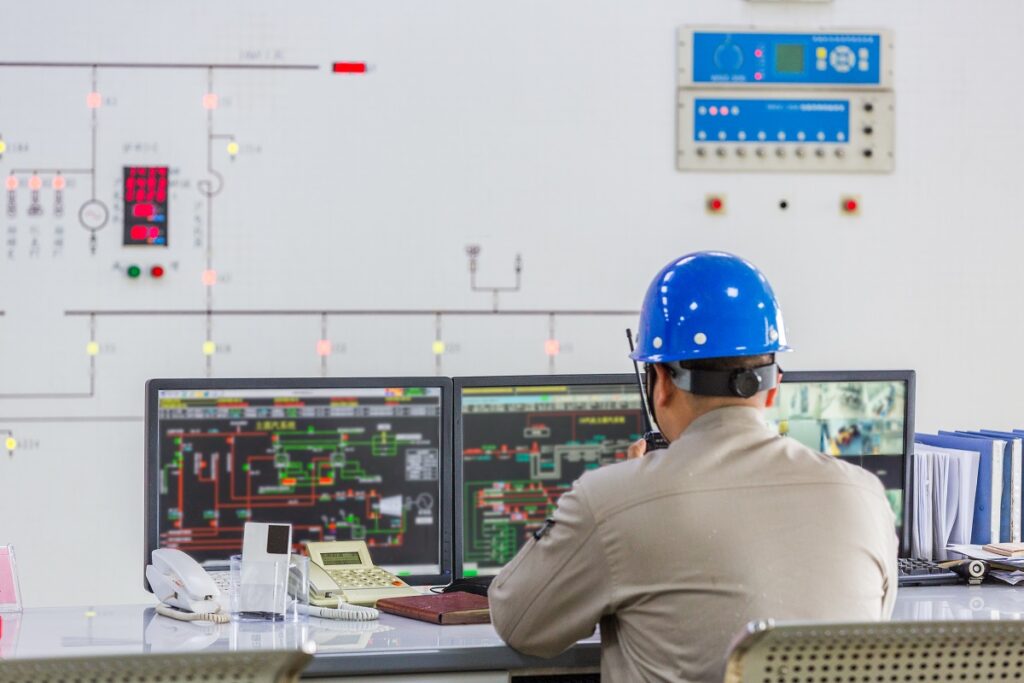Building Management Systems: The Key to Efficient Infrastructure

In the modern world, the importance of Building Management Systems (BMS) cannot be overstated. These systems are the backbone of efficient, sustainable, and secure infrastructure. But what exactly is a BMS, and why is it so crucial in today’s world?
Understanding Building Management Systems
What is Building Management System
A Building Management System (BMS), alternatively known as a Building Automation System (BAS), is an advanced mechanism designed to control and oversee the multiple subsystems within a building. These subsystems encompass areas such as heating, ventilation, and air conditioning (HVAC), lighting, security mechanisms (like intercoms), fire safety measures, and even power systems.
The fundamental objective of a BMS is to establish an environment within the building that is both efficient and comfortable for its occupants. It also aims to minimize energy consumption and maintenance expenses. This is achieved by automating and streamlining the operation of the building’s various systems. For instance, a BMS can autonomously modify the temperature and lighting based on the time of day or the number of occupants, or it can notify the maintenance team about potential issues before they escalate into serious problems.
At its essence, a BMS consists of sensors, controllers, and actuators. The role of sensors is to measure variables such as temperature, humidity, and light intensity, while controllers interpret this data and make decisions based on pre-determined parameters. Actuators, which could range from motors to valves, then execute these decisions. For example, if a sensor identifies that a room’s temperature is too low, the controller will command an actuator to augment the heat output of the HVAC system.
Beyond these fundamental components, a BMS typically incorporates a user interface that enables building managers to monitor and adjust the system. This interface can provide invaluable data on the building’s operational performance, energy consumption, and potential maintenance issues.
In essence, a Building Management System is a holistic solution for managing a building’s diverse systems, delivering enhanced efficiency, comfort, and safety.
The Purpose and Function of a BMS
The BMS serves a multitude of purposes and functions within a building’s infrastructure. Its primary role is to control, monitor, and optimize the building’s operations and services. Here’s a more detailed look at the purpose and function of a BMS:
- Control and Monitoring: The BMS provides a centralized system for controlling and monitoring the building’s mechanical and electrical equipment such as ventilation, lighting, power systems, fire systems, and security systems. It allows for real-time monitoring and fine-tuning of these systems, ensuring they are functioning optimally and efficiently.
- Energy Efficiency: One of the main functions of a BMS is to enhance energy efficiency. By controlling and optimizing the operation of HVAC systems, lighting, and other energy-consuming components, a BMS can significantly reduce energy usage and costs. It can adjust the temperature and lighting based on occupancy levels or time of day, and it can also identify and alert maintenance staff to any issues that could lead to energy waste.
- Comfort and Convenience: A BMS also plays a crucial role in ensuring the comfort and convenience of the building’s occupants. It can maintain optimal temperature, lighting, and ventilation conditions, and it can also allow occupants to control these conditions to suit their personal preferences.
- Safety and Security: Safety and security are another important function of a BMS. The system can monitor and control access to the building, manage CCTV and alarm systems, and ensure that fire and safety systems are functioning properly.
- Maintenance and Troubleshooting: A BMS can help to streamline maintenance tasks and identify potential issues before they become serious problems. By monitoring the performance of various systems and equipment, the BMS can alert maintenance staff to any anomalies or malfunctions, allowing them to address these issues promptly and prevent downtime.
- Data Collection and Analysis: A BMS can collect and analyze data on various aspects of the building’s performance, including energy usage, system efficiency, and occupancy patterns. This data can provide valuable insights for building managers, helping them to make informed decisions about energy management, maintenance scheduling, and other operational aspects.
Components of a BMS
A Building Management System (BMS) is a complex network of hardware and software components that work together to control and manage various systems within a building. These components can be broadly categorized into four main types: sensors, controllers, output devices, and a user interface.
- Sensors: Sensors are the eyes and ears of a BMS. They continuously monitor various parameters within the building, such as temperature, humidity, light levels, occupancy, and energy usage. The data collected by these sensors is then sent to the controllers for processing.
- Controllers: Controllers are the brains of the BMS. They receive data from the sensors and make decisions based on this information and the pre-set parameters. For example, if a sensor detects that a room is too hot, the controller will decide to turn on the air conditioning in that room.
- Output Devices: Output devices, also known as actuators, are the hands and feet of the BMS. They carry out the decisions made by the controllers. In the previous example, the actuator would be the mechanism that actually turns on the air conditioning. Other examples of output devices include valves, dampers, switches, and motors.
- User Interface: The user interface is the part of the BMS that allows humans to interact with the system. It provides a visual representation of the building’s systems and their current status. Building managers can use the user interface to monitor the building’s performance, adjust settings, and respond to alerts. The user interface can be a dedicated terminal or a software application that can be accessed from a computer or mobile device.
In addition to these main components, a BMS may also include various other elements such as communication networks, databases for storing information, and software applications for analyzing data and generating reports.
The components of a BMS work together to monitor, control, and optimize the operation of a building’s systems, ensuring a comfortable, safe, and energy-efficient environment.
The Evolution of Building Management Systems

A Brief History of BMS
The history of Building Management Systems (BMS) is a fascinating journey that reflects the rapid advancements in technology over the past few decades.
In the earliest days of building management, systems were largely manual and rudimentary. Building managers had to physically adjust settings for heating, ventilation, and air conditioning (HVAC), and other systems, based on their observations and the comfort of the building’s occupants. This was a time-consuming and inefficient process that often led to energy waste and inconsistent conditions within the building.
The first major evolution in building management came with the advent of electromechanical systems in the mid-20th century. These systems used electrical and mechanical components to automate some aspects of building management, such as temperature control. However, they were still relatively simple and lacked the ability to monitor and optimize building performance.
The real revolution in building management began in the 1980s with the development of computer-based BMS. These systems used microprocessors to control and monitor a wide range of building systems, from HVAC and lighting to security and fire safety. They provided a centralized platform for building management, allowing for real-time monitoring and control of various systems. This led to significant improvements in energy efficiency, comfort, and safety.
The next major leap in BMS technology came with the rise of the internet in the late 1990s and early 2000s. Internet connectivity allowed for remote access and control of BMS, providing even greater flexibility and efficiency. It also enabled the integration of BMS with other IT systems, leading to the development of smart buildings.
Today, BMS are becoming increasingly sophisticated, with the integration of artificial intelligence (AI) and machine learning technologies. These technologies allow for predictive maintenance, where the BMS can identify potential issues before they become problems, and adaptive control, where the system can learn from past performance to optimize future operations.
Types of Building Management Systems
Building Management Systems (BMS) come in various types, each with its unique features and benefits. Here are some of the most common types:
- Centralized BMS: These systems have a single, central control unit that monitors and controls all the building’s systems. They are typically used in smaller buildings where all systems can be easily managed from one location.
- Decentralized BMS: In these systems, control is distributed across multiple units throughout the building. This allows for more flexibility and scalability, making it suitable for larger or more complex buildings.
- Integrated BMS: These systems integrate the control of multiple building systems, such as HVAC, lighting, and security, into a single platform. This allows for more efficient and coordinated operation of the building’s systems.
- Non-integrated BMS: These systems manage each building system separately, with separate controls for each system. While this can provide more detailed control over individual systems, it lacks the coordination and efficiency of an integrated system.
- Intelligent BMS: These are the most advanced type of BMS, incorporating technologies such as artificial intelligence and machine learning to optimize building performance. They can predict and adapt to changing conditions, providing the highest level of efficiency and comfort.
Here’s a chart summarizing these types:
| Type | Central Control | Integration | Scalability | Advanced Technologies |
|---|---|---|---|---|
| Centralized BMS | Yes | Varies | Limited | No |
| Decentralized BMS | No | Varies | High | No |
| Integrated BMS | Varies | Yes | Varies | No |
| Non-integrated BMS | Varies | No | Varies | No |
| Intelligent BMS | Varies | Yes | High | Yes |
Each type of BMS has its strengths and weaknesses, and the best choice will depend on the specific needs and characteristics of the building.
Benefits of Implementing a Building Management System

Implementing a Building Management System (BMS) can bring a multitude of benefits to a building’s operation. Here are some of the key benefits:
- Cost Savings: By optimizing the operation of HVAC, lighting, and other energy-consuming systems, a BMS can significantly reduce energy costs. It can also reduce maintenance costs by identifying potential issues before they become serious problems.
- Energy Efficiency: A BMS can enhance a building’s energy efficiency by ensuring that systems are only used when needed and that they operate at optimal levels. This not only reduces energy costs but also contributes to sustainability and reduces the building’s environmental impact.
- Improved Security: With a BMS, building security can be significantly enhanced. The system can monitor access control, CCTV, and alarm systems, ensuring a safe and secure environment for occupants.
- Enhanced Comfort and Convenience: A BMS can improve the comfort and convenience of a building’s occupants by ensuring optimal temperature, lighting, and ventilation conditions. It can also allow occupants to control these conditions to suit their personal preferences.
- Sustainability and Environmental Benefits: By optimizing energy usage and reducing waste, a BMS can contribute to sustainability and offer significant environmental benefits.
Here’s a chart summarizing these benefits:
| Benefit | Description | Impact |
|---|---|---|
| Cost Savings | Optimizes operation of systems to reduce energy and maintenance costs | Reduces operational costs |
| Energy Efficiency | Ensures systems are used efficiently and optimally | Reduces energy usage and environmental impact |
| Improved Security | Monitors and controls security systems | Enhances safety and security for occupants |
| Enhanced Comfort and Convenience | Maintains optimal temperature, lighting, and ventilation conditions | Improves occupant satisfaction and productivity |
| Sustainability and Environmental Benefits | Optimizes energy usage and reduces waste | Contributes to sustainability and reduces environmental impact |
Choosing the Right Building Management System

Factors to Consider When Choosing a BMS
- Building Size and Complexity: The size and complexity of your building will largely determine the type of BMS you need. Larger or more complex buildings may require a more sophisticated system with advanced features and capabilities.
- Specific Needs: Consider the specific needs of your building and its occupants. Do you need advanced energy management features? Is security a major concern? Do you need to monitor and control a wide range of systems? Your specific needs will guide you in choosing a BMS with the right features.
- Budget: Your budget is another important factor to consider. BMS can range in price significantly, depending on their features and capabilities. It’s important to balance your needs and budget to choose a system that offers the best value.
- Scalability: Consider the future needs of your building. If you plan to expand or upgrade your building in the future, you’ll want a BMS that can scale to meet these needs.
- Ease of Use: A BMS should be user-friendly and easy to operate. Look for systems with intuitive user interfaces and good customer support.
- Integration Capabilities: If you have existing systems in your building, you’ll want a BMS that can integrate with these systems. This can provide more efficient and coordinated operation of your building’s systems.
- Vendor Reputation: Finally, consider the reputation of the BMS vendor. Look for vendors with a track record of reliable and high-quality systems, good customer support, and ongoing updates and improvements.
Tips for Selecting the Right BMS for Your Needs

- Understand Your Needs: The first step in selecting the right BMS is to understand your specific needs. What are the key challenges you are facing in managing your building? What are your goals for energy efficiency, comfort, and security? By understanding your needs, you can identify the features and capabilities that are most important to you.
- Research Different Systems: Once you have a clear understanding of your needs, start researching different BMS. Look at the features and capabilities of each system, and consider how well they align with your needs.
- Consider the Total Cost of Ownership: When evaluating different BMS, consider not only the initial purchase price but also the total cost of ownership. This includes the costs of installation, operation, maintenance, and upgrades. A system with a lower purchase price may end up costing more in the long run if it is expensive to operate and maintain.
- Ask for a Demonstration: Before making a decision, ask the vendor for a demonstration of the BMS. This can give you a better understanding of how the system works and how easy it is to use.
- Get References: Ask the vendor for references from other customers who have used their BMS. Contact these customers and ask about their experiences with the system and the vendor.
- Plan for the Future: Finally, consider your future needs when selecting a BMS. If you plan to expand or upgrade your building in the future, you’ll want a system that can scale to meet these needs.
Case Study: Successful Implementation of a Building Management System
In this section, we will explore a detailed case study of a successful BMS implementation, highlighting the lessons learned and best practices.
Future Trends in Building Management Systems
The Building Management System (BMS) industry is constantly evolving, with new trends and technologies shaping the future of building management. Here are some of the emerging trends in the BMS industry:
- Integration of Artificial Intelligence (AI) and Machine Learning: AI and machine learning are being increasingly integrated into BMS. These technologies can analyze large amounts of data to identify patterns and make predictions, allowing for more efficient and proactive building management. For example, AI can predict when a piece of equipment is likely to fail and schedule maintenance before a breakdown occurs.
- Internet of Things (IoT): The IoT is playing a significant role in the evolution of BMS. IoT devices can collect and transmit data in real-time, providing more accurate and timely information for building management. This can lead to more efficient operation and better decision-making.
- Cloud-Based Systems: More and more BMS are moving to the cloud. Cloud-based systems offer several advantages, including lower upfront costs, easier scalability, and the ability to access the system from anywhere.
- Cybersecurity: As BMS become more connected and complex, cybersecurity is becoming a critical concern. Protecting the data and systems within a BMS from cyber threats is a key focus in the industry.
- Sustainability: With increasing awareness of climate change and the environmental impact of buildings, there is a growing focus on sustainability in the BMS industry. Modern BMS are being designed to optimize energy efficiency and reduce the environmental footprint of buildings.
- User-Friendly Interfaces: As BMS become more sophisticated, there is a trend towards more user-friendly interfaces. This makes it easier for building managers to monitor and control their building’s systems, even without specialized technical knowledge.
- Predictive Maintenance: With the help of AI and machine learning, BMS are moving towards predictive maintenance. This means the system can identify potential issues before they become problems, reducing downtime and maintenance costs.
These emerging trends are set to shape the future of the BMS industry, making building management more efficient, sustainable, and user-friendly. As technology continues to advance, we can expect to see even more innovative features and capabilities in BMS.
Conclusion
In conclusion, Building Management Systems are a crucial component of modern infrastructure. They offer a host of benefits, including cost savings, improved energy efficiency, enhanced security, and increased comfort and convenience. By choosing the right BMS for your needs, you can optimize your building’s performance and ensure a sustainable, efficient, and secure environment. As we look to the future, the ongoing evolution of BMS promises even more exciting developments in the world of building management.